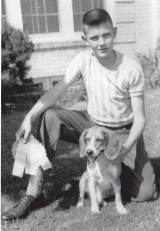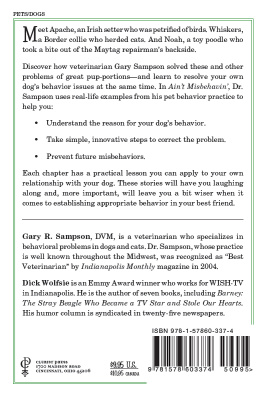Copyright 2005 by Gary R. Sampson and Dick Wolfsie All rights reserved. No portion of this book may be reproduced in any fashion, print, facsimile, or electronic, or by any method yet to be developed, without express permission of the copyright holder.
This work was previously titled Dog Dilemmas, published by Emmis Books.
Sampson, Gary R.
Dog dilemmas/Gary R. Sampson with Dick Wolfsie.
p. cm.(Pet peeves)
1. DogsBehavior. 2. DogsTraining. I. Wolfsie, Dick. II.
Title. III. Series.
Introduction
As a veterinarian who limits his practice to dog and cat behavior modification, I have been dealing with the misbehavior of humans for twenty years.
Of course, humans are not completely responsible for the conduct of their pets. All animal behavior is a curious combination of the animals instincts and the effects of the conditions he is raised in. But, yes, you are the conditions.
The relationship between man and dog goes back tens of thousands of years. And both parties are pretty happy with the arrangement. Humans acquired an animal capable of great loyalty, one that would act not just as a companion, but as a protector and hunter. Dogs got a pretty good deal, as well. Its a lot easier to wait for your food to be put in a bowl than it is to stalk a wildebeest. And I kind of think that getting scratched behind the ears was the dogs idea.
Over time, the dog became more and more domesticated, gradually moving from the barn, to the porch, to the kitchen, and finally into the bedroom. The canines distinctive personality became part of the family dynamics. Now, when I hear about dogs that sleep under the covers with their owners, I wonder if things havent gone too far.
In fact, this is probably the reason you have bought this book. You have a dog that does not fit your image of how a family pet should behave. Your sheltie barks too much; your doxie isnt housebroken; your boxer chews the antique chair leg. These are pretty common problems, but, as you will discover, every dog is different. Every owner is different. Every situation is different.
My role is to help people understand why a 110-pound rottweiler is afraid of a thunderstorm and a 10-pound poodle chases the 200-pound mailman. If there were simple solutions to these problems, I would just fax my clients a checklist of dos and donts. But it doesnt work that way.
In our first phone conversation, I want the owner to tell me all about the dog. Among other things, I inquire about the dogs background and how he fits into the family. Of course, I also want to know exactly what the problem is and how it has been dealt with up to this point.
I am not content with just offering a solution. I want my clients to understand why the problem exists, because it gives them a better appreciation of how my directions for addressing the issue have a pretty good chance of working.
My suggestions are successful only when the client is willing and able to make a commitment to change his or her behaviorbecause only then will the dogs behavior change. Thats not always easy. For example, I may tell a client not to pick up his Chihuahua when he is trembling out of fear. Thats the worst thing you can do, Ill say. Thats tough for some people, but thats where a full explanation is so important. Then when the client says, Oh, now I see why you said that, thats a pretty good indication my advice has been heard and understood. By the way, dont pick up your Saint Bernard either, but this time I have two good reasons.
Every day in this country, thousands of people abandon their dogs or relinquish them to humane societies and animal shelters. Why? Because their dog has a behavior problem that they cannot deal with. And sadly, it is probably a behavior problem they contributed to or are inadvertently reinforcing. Thats where I come in. The people who call me love their pets and are looking for assistance. But for the thousands of people each year who might give up on their dogs, I hope this book will be a wake-up call that help is available.
All the stories are based on real cases, though on occasion I have combined incidents so that a more typical example can be represented. Youll meet a dog who loved to catch moles and one that was scared of birdsjust a parade of quirky behaviors that stumped my clients but will both amuse you and educate you about your pet.
By the way, if your dog loves to chew paperbacks, make sure he cant reach this one. And dont miss . Now theres a dog that could sink his teeth into a good book.
Barney, Dick Wolfsie, and Me
Although I have worked with thousands of dog and cat owners, I am probably best known for the six minutes I spent on a TV show with Dick Wolfsie in the fall of l992. That episode is chronicled in Dicks book about his infamous dog. People ask me about it even now, years later.
Dick found Barney on his front step in l991, and it wasnt long before the renegade little pooch was eating, chewing, and digging himself into deep trouble. Because Dicks wife could not tolerate the dogs destructiveness, she encouraged Dick to take Barney with him to work each morning during his show on WISH-TV.
At that time, I was beginning a new chapter in my life, as well. For thirty years I had been employed as an industrial veterinarian working to develop animal health products. But beginning in the mid-80s, I decided to develop a veterinary practice limited to dog and cat behavior problemsalways an interest of mine.
I had been watching Dick Wolfsie on TV for several years and, like so many viewers, was captivated by his new TV companion. For me, their relationship was especially endearing because as a young boy, I, too, had a beagle. His name was Duffy.
I believe all beagle owners deal with similar problems. Beagles are a spirited, inquisitive, high-energy breed that will love you to death, but also be the death of you. They are diggers, chewers, chow hounds, and escape artists. Thats how I remembered Duffy. Duffy was also the neighborhood stud. In fact, I used Duffy the love machine as a way to make money to purchase my first car, renting out Duffys services to people who wanted to breed beagles.
Duffy also did occasional freelance work, sometimes gone days at a time. My mother kept a calendar of which dogs in the neighborhood were in heat, so if Duffy missed a meal (which beagles seldom do) shed have a pretty good idea of what had detained him and where I should go to get him.













